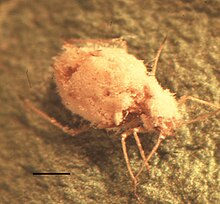| Pandora | |
|---|---|

| |
| Myzus persicae killed by Pandora neoaphidis | |
| Scientific classification | |
| Domain: | Eukaryota |
| Kingdom: | Fungi |
| Division: | Entomophthoromycota |
| Class: | Entomophthoromycetes |
| Order: | Entomophthorales |
| Family: | Entomophthoraceae |
| Genus: | Pandora R. A. Humber, 1984 [1] |
| Synonyms | |
| |
Pandora is a genus of fungi within the order Entomophthorales.[2] This has been supported by molecular phylogenetic analysis (Gryganskyi et al. 2012).[3]
It was initially formed by Polish mycologist Andrzej Batko (1933-1997), as a subgenus of Zoophthora.[4] Then American mycologist Richard A. Humber raised it to the genus level.[1] The genus name of Pandora is derived from the Latin word pando which means “to become curved” or “to sag” and the generic suffix “ra” thus describing conidia, which are often with weakly outlined bilateral symmetry. They are on one side (abdominal) slightly flattened and on the opposite (dorsal) side, more convex, on the third (lateral) side, they are somewhat curved towards the abdominal side and slightly asymmetrical.[4]
It has a cosmopolitan distribution.[5]
It is best known by its representative Pandora neoaphidis, which acts as an obligate pathogen in various species of aphids. It is a widespread species that is often found to be the most common fungal insect pathogen on the local aphid community (e.g. in surveys from Argentina,[6] Slovakia,[7] and China.[8]). It has therefore been the subject of study for biological control. Including usage on the green peach aphid, Myzus persicae (Homoptera: Aphididae) which predates on spinach (Spinacea oleracea L.) in Arkansas, America. Up to 95 species of the aphid (world-wide) have been found to be infected by the fungus. From places such as France (Rabasse et al. 1983), Mexico (Remaudiere and Hennebert, 1980), Portugal and Spain (Humber, 1986) and also Japan (Kobayashi et al.,1984).[9] Panicum miliaceum or broomcorn millets were trialled in 2003 as a production base (within labs) for the fungus.[10] However, difficulty with mass production of infectious spores in vitro and the viable formulation and storage into an easily applicable commercial product has halted their direct use as a biological control in 2012.[11]
There is limited evidence that the ladybird Harmonia axyridis, which is invasive in America and Europe, has an advantage over native ladybird species because it feeds more on Pandora-infested aphid cadavers.[12]
Pandora formicae (Humber & Bałazy) Humber is a rare example of the entomophthoralean fungus that has adapted to exclusively infect social insects, such as the wood ant Formica polyctena. The proportion of dead ant bodies with resting spores increased from late summer throughout autumn, which suggests that these fungal spores are the main overwintering fungal structures.[13]
Pandora sp. nov. inedit. (ARSEF13372) is a recently isolated fungus species with high potential for usage in psyllid pest control. Experiments in biomass production are being studied for usefulness.[14]
- ^ a b Humber, R. A. 1984. Mycotaxon, 21, 257-264.
- ^ Elya, Carolyn; De Fine Licht, Henrik H. (12 November 2021). "The genus Entomophthora: bringing the insect destroyers into the twenty-first century &". IMA Fungus. 12 (34).
- ^ Gryganskyi AP, Humber RA, Smith ME et al (2012) Molecular phylogeny of the Entomophthoromycota. Mol Phylogenet Evol 65:682–694. https://doi.org/10.1016/j.ympev.2012.07.026
- ^ a b Batko, A. 1966. Acta Mycologica, 2, 15-21.
- ^ "Pandora Humber". www.gbif.org. Retrieved 29 December 2022.
- ^ Cite error: The named reference
Scorsetti 2007was invoked but never defined (see the help page). - ^ Cite error: The named reference
Barta 2006was invoked but never defined (see the help page). - ^ Cite error: The named reference
Li 2007was invoked but never defined (see the help page). - ^ Elkassabany, N. M.; Steinkraus, D. C.; McLeod, P. J.; Correll, J. C.; Morelock, T. E. (April 1992). "Pandora neoaphidis (Entomophthorales: Entomophthoraceae): A Potential Biological Control Agent against Myzus persicae (Homoptera: Aphididae) on Spinach". Journal of the Kansas Entomological Society. 65 (2): 196–199.
- ^ Hua, Li; Feng, Ming-Guang (24 October 2003). "New use of broomcorn millets for production of granular cultures of aphid-pathogenic fungus Pandora neoaphidis for high sporulation potential and infectivity to Myzus persicae". FEMS Microbiol Lett. 227 (2): 311–7. doi:10.1016/S0378-1097(03)00711-0.
- ^ Vega FE, Meyling NV, Luangsa-ard JJ, Blackwell M (2012) Chapter 6—fungal entomopathogens. In: Vega FE, Kaya HK (eds) Insect pathology, 2nd edn. Academic Press, San Diego, pp 171–220
- ^ Cite error: The named reference
Roy 2008was invoked but never defined (see the help page). - ^ Małagocka, Joanna; Bruun Jensen, Annette; Eilenberg, Jørgen (February 2017). "Pandora formicae, a specialist ant pathogenic fungus: New insights into biology and taxonomy". J. Invertebr. Pathol. 143: 108–114. doi:10.1016/j.jip.2016.12.007.
- ^ Muskat, Linda C.; Przyklenk, Michael; Humbert, Pascal; Eilenberg, Jørgen; Patel, Anant V. (25 April 2022). "Fermentation of the psyllid-pathogenic fungus Pandora sp. nov. inedit. (Entomophthorales: Entomophthoraceae)". Biocontrol Science and Technology. 32 (5): 564–585. doi:10.1080/09583157.2022.2035680.